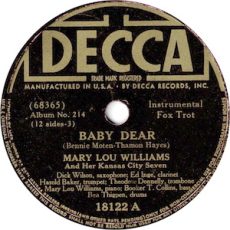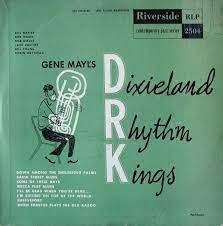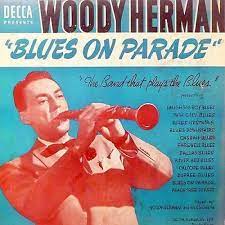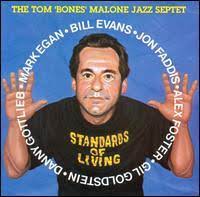
Daily Dose Of Jazz…
David W. Bargeron was born September 6, 1942 in Atho, Massachusetts. He became the lead trombonist with Clark Terry’s Big Band and played bass trombone and tuba with Doc Severinsen’s Band between 1968 and 1970.
In 1970 he joined Blood, Sweat, and Tears after Jerry Hyman departed and first appeared on the album B, S & T; 4. While with this group, he recorded the jazz-rock solo on the tuba in And When I Die/One Room Country Shack on the album Live and Improvised. His recording credits with BS&T include eleven albums. A break in their schedule allowed him to join the Gil Evans Orchestra in 1972.
After leaving Blood, Sweat, and Tears he became a freelance musician recording with Billy Joel, Paul Simon, Mick Jagger, James Taylor, Eric Clapton, David Sanborn, Carla Bley, and Pat Metheny.
He has performed with the George Gruntz Concert Jazz Band from Switzerland, the George Russell Living Time Orchestra, and was a long-time member of Jaco Pastorius’s Word of Mouth Band. He has recorded and toured with Tuba Tuba, a jazz tuba band which includes Michel Godard, Luciano Biondini, and Kenwood Dennard.
He is a member of Howard Johnson’s Gravity, a six-tuba group that has been together since 1968. Trombone and tubist David Bargeron, who has released several albums as a soloist and collaborator, at 80 still performs.

Daily Dose Of Jazz…
Booker Collins was born on June 21, 1914 in Roswell, New Mexico. Emerging from the New Mexico Military Institute to play in Bat Brown’s Band, a territory band. By the mid-’30s he was keeping very good company playing with pianist Mary Lou Williams and Her Kansas City Seven, cutting sides with her when he was only 16. In 1934, his break came when he got into the band of Andy Kirk and His Clouds Of Joy, staying for the next decade and playing alongside Williams in the rhythm section. Kirk’s hiring replaced the tuba with the double bass.
Booker’s final job of note was with Chicago, Illinois guitarist and drummer Floyd Smith as part of his trio, a stint that lasted from 1946 until the early ’50s, when this great bass man finally laid his big instrument down in terms of full-time playing. He made a few appearances at festival occasions in the ensuing decades but was in Chicago’s recording studios in the late ’50s cutting sides for independent labels.
Returning to performing he joined a combo called the Shades of Rhythm to backup blues singer Mad Man Jones on the demanding Come Here. Collins’ involvement with this group of shifting personnel began in 1952 when he was part of a version that took the risk of cutting sides for the Chance label.
He also performed and recorded with Bert Johnson and the group Six Men And A Girl. Little is known about the death of double bassist Booker Collins who also played the valve trombonist and tuba. It appears he faded into obscurity.
More Posts: bass,history,instrumental,jazz,music,trombone,tuba

Daily Dose Of Jazz…
Gene Mayl was born in Dayton, Ohio on December 30, 1928. He lived in France after World War II, where he worked with Claude Bolling, Don Byas, and Claude Luter.
In 1948, he formed his own Dixieland revival ensemble, the Dixieland Rhythm Kings, which recorded for London Records and Riverside Records, and was active through the mid-1970s. Among those he worked with in this group were Speckled Red and Terry Waldo.
Mayl worked extensively with George Brunis in the 1960s and 1970s, and also worked with Wild Bill Davison, Billy Maxted, Bob Scobey, and Muggsy Spanier. Double-bassist, tubaist, and vocalist Gene Mayl transitioned on May 5, 2015 in Harrison Township, Ohio.

Daily Dose Of Jazz…
Joe Bishop was born November 27, 1907 in Monticello, Arkansas and learned piano, trumpet, and tuba when he was young. He also played flugelhorn and mellophone. He attended Hendrix College and played professionally with the Louisiana Ramblers in 1927, including in Mexico.
Bishop played with Mart Britt, Al Katz, and Austin Wylie before joining the Isham Jones band for five years. He was a founding member of Woody Herman’s band in the 1930s, but he contracted tuberculosis in 1940 and had to leave the group. He was rehired by Herman as a staff arranger later in the 1940s, and his arrangements and compositions were recorded frequently by Herman, appearing on some 50 of Herman’s albums.
As a performer, Joe played with Cow Cow Davenport and Jimmy Gordon’s Vip Vop Band, but retired from studio work due to his health in the 1950s. Joe quit music and opened a store in Saranac Lake, New York, and later retired to Texas. His compositions include Midnight Blue, Woodchopper’s Ball, and Blue Prelude with Gordon Jenkins.
Tubist, pianist and composer Joe Bishop, whose work has been covered by musicians as diverse as Ten Years After and Lawrence Welk, transitioned on May 12, 1976.
More Posts: composer,history,instrumental,jazz,music,piano,tuba

Daily Dose Of Jazz…
Thomas “Bones” Malone was born June 16, 1947 in Honolulu, Hawaii. He began playing professionally as lead trumpeter for Brenda Lee at a club in Jackson, Mississippi while enrolled at the University of Southern Mississippi. In response to a call from Warren Covington, leader of the Tommy Dorsey Orchestra, he began contracting musicians. After transferring to North Texas State University, Malone continued working as both a player and a contractor for groups. He graduated from North Texas State University with Lou Marini, and both were members of the One O’Clock Lab Band at North Texas.
After graduation, he worked in bands of Woody Herman in 1969, and during the early Seventies he worked with Duke Pearson, Louie Bellson, Doc Severinsen, Frank Zappa, and Blood, Sweat & Tears. In 1973, Malone began a close, fifteen-year association with Gil Evans, whom he has called a mentor. He recorded albums with Evans and toured Europe, Japan, and the Far East. In 1975 Malone toured with Billy Cobham and in 1976 with The Band.
From 1975 to 1985 he worked as arranger for Saturday Night Live and from 1981 to 1985 as musical director. He wrote the chart for the skit that introduced John Belushi and Dan Aykroyd as the Blues Brothers and worked on the film score for Blues Brothers 2000. He joined the CBS Orchestra in 1993, and contributed more than 1,600 arrangements to the Late Show with David Letterman.
As a studio musician, he has been heard on more than 1,000 records, more than 3000 radio and television commercials, and over 4,000 live television shows. In 2007 Bones was invited by music director Geoffrey Moull to arrange and perform a concert with the Thunder Bay Symphony Orchestra. In 2011 Malone was a guest artist with the University of Southern Mississippi Symphony Orchestra.
Trombonist, arranger, and producer Tom Malone, who also plays saxophone, trumpet, tuba, flute, and bass guitar, continues to expand his creative reach.
More Posts: bass guitar,flute,history,instrumental,jazz,music,saxophone,trombone,trumpet,tuba




